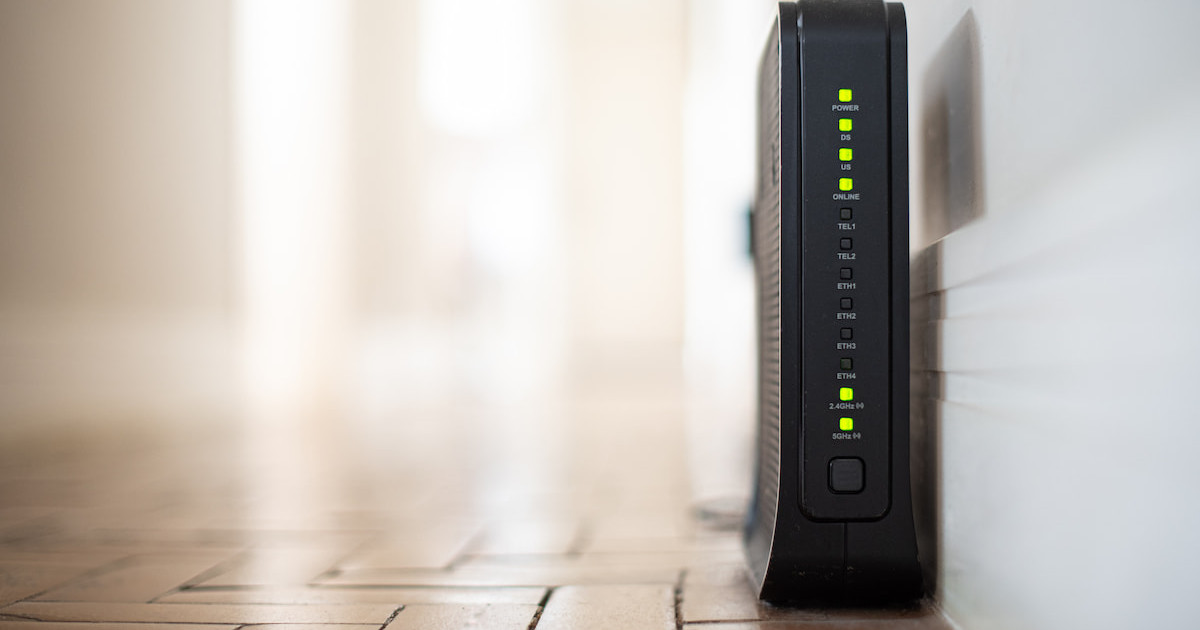Wi-Fi 6 vs. Wi-Fi 6E: What’s the Difference?
Wi-Fi 6E opens up a whole new frontier for superfast wireless speeds.
Oct 10, 2023 | Share
Technology
Understanding all the different Wi-Fi standards can be a real pain. We get it. A sad Wi-Fi 5 waves goodbye in the rearview mirror. Wi-Fi 6 is the new norm, Wi-Fi 6E is slowly replacing Wi-Fi 6, and Wi-Fi 7 routers and devices are now popping up in stores. Oh, and let’s not forget Wi-Fi 6 Release 2.
Yep. Wi-Fi this. Wi-Fi that. What a Wi-Fi headache.
Just to be clear, we think Wi-Fi 6E is a bandage. Technically, it’s an extension of Wi-Fi 6, but we use the term “bandage” because Wi-Fi 6E only addresses the real-world gigabit Wi-Fi speed woes experienced with Wi-Fi 6. How? By adding access to the new 6 GHz spectrum.
So, is this half-step worthy of an upgrade? We’ll explain why this new spectrum is important so you can decide whether to upgrade to Wi-Fi 6E now or skip it and go with Wi-Fi 7.
Do you have the internet speeds you need for Wi-Fi 6E?
A single Wi-Fi 6E device can support speeds up to 2,400Mbps. Enter your zip code below to see if plans in your area can match those speeds.
Wi-Fi 6 vs. Wi-Fi 6E: The similarities
Before we jump down the deep, dark rabbit hole to discuss what divides these two specifications, let’s stroll down memory lane for a moment and remember how Wi-Fi 6 improves upon Wi-Fi 5.
In a nutshell, Wi-Fi 6 has slightly faster real-world speeds than Wi-Fi 5, is more efficient, and offers more capacity. If you’re still surfing on a Wi-Fi 5 router, consider an upgrade soon. Like, real soon.
Here are the main callouts of Wi-Fi 6:
| Upgraded | Added |
|---|---|
|
|
Now let’s look at what’s changed since Wi-Fi 6 was first released.
Wi-Fi 6 Release 2
To add more confusion to all the Wi-Fi jargon, the Wi-Fi Alliance launched Wi-Fi 6 Release 2 in early 2022. This revision added the following features:
- MU-MIMO uplink
- Broadcast target wake time
- Extended sleep time
- Dynamic multi-user spatial multiplexing power save (SMPS)
In summary, simultaneous uploads to the router weren’t a thing until Release 2. With Wi-Fi 6 and Wi-Fi 5, devices waited in a single-file line to upload data to the router, even though that wasn’t the case with downloads. This upgrade means less latency in gaming and video conferencing.
The other three additions are snore-inducing power management features targeting IoT and enterprise devices, so we’ll just move on.
Now meet Wi-Fi 6E
The Wi-Fi Alliance launched Wi-Fi 6E in 2020, so it took a few years for compatible devices to saturate the mainstream market. Everything mentioned so far is included in Wi-Fi 6E—even the new Wi-Fi 6 Release 2 goodies. Sometimes, you may see this spec listed as Wi-Fi 6E Wave 2.
And as we mentioned earlier, Wi-Fi 6E is an extension of Wi-Fi 6. The two specs are identical except for one glaring feature: the new 6 GHz connection.
Wi-Fi 6 vs. Wi-Fi 6E: The one difference
Wi-Fi 6E supports the 6 GHz band, and Wi-Fi 6 doesn’t. That’s it. That’s the only difference between the two specifications. But it’s a significant uptick because it opens up a whole new Wi-Fi frontier to homes and businesses that don’t get the real-world wireless gigabit speeds they need from a 5 GHz connection.
| 6 GHz pros | 6 GHz cons |
|---|---|
|
|
To fully understand why the 6 GHz connection is so important, we need to take a closer look at what plagues the 5 GHz band.
First, the 5 GHz band is way crowded
Once upon a time, we were told to jump on the 5 GHz band because it’s less crowded and faster than a 2.4 GHz connection. Sure, it has a shorter range than the 2.4 GHz spectrum and has a hard time penetrating thick objects, but the sweet, sweet unobstructed speeds make up for the range shortcoming.
Now fast-forward to the present. Run a Wi-Fi analyzer app, and you’ll see that everyone under the sun uses the 5 GHz spectrum now—your neighbor, your boss, your local Walmart. All these Wi-Fi networks collide and cause interference that can slow your wireless speeds down to an annoying crawl.
To possibly reduce interference and speed up your connection, you can change the router’s channel, right? Read on while we quietly giggle for a moment.
Get off my channel!
The 5 GHz band has 25 usable channels, each measuring 20 megahertz wide. Routers bond these channels together to create larger ones that push more data through the air. For instance, one 80 MHz channel combines four adjacent channels, such as channels 36, 40, 44, and 48.
The problem is everyone wants loads of speed. The 80 MHz channel width is the sweet spot for fast Wi-Fi and the default setting in every router we’ve tested. So, chances are high that another nearby network uses the same channel group you’re trying to use. Heck, you may be bombarded by multiple networks that hog all the channels and keep your speeds low no matter which one you choose.
To make matters worse, 16 of the available 25 channels may be unusable if you live near an airport or weather station, reducing your channel selection to a handful. This limitation can be problematic if you want superfast Wi-Fi speeds, and we’ll explain why in the next section.
The 5 GHz band fights with pesky radar
Radar systems occupy channels 52–64 and 100–140 and take precedence over home network use. Airports, weather stations, military bases, and everything else the Federal Communications Commission (FCC) deems a priority use these radar systems.
The FCC allows home networks to use these channels through a mechanism called Dynamic Frequency Selection (DFS). In short, routers and other wireless devices listen for radar events and stop transmitting if radar is detected—whether they’re actual events or false ones—or switch to a different, possibly narrower channel.
| Sub-band group | U-NII-1 | U-NII-2 | U-NII-2e | U-NII-3 |
|---|---|---|---|---|
| Channels | 36–48 | 52–64 | 100–140 | 149–165 |
| DFS | No | Yes | Yes | No |
Obviously, DFS channels are not ideal if you live within 10 miles of a radar system. To avoid radar woes, use the following channels:
| Channel width | 20 MHz | 40 MHz* | 80 MHz* |
|---|---|---|---|
| Channel group 1 | 36, 40, 44, 48 | 38, 46 | 42 |
| Channel group 2 | 149, 153, 157, 161 | 151, 159 | 155 |
* You probably won’t see these channels listed on your router. Instead, the router creates them when you select a 20 MHz channel and a 40 MHz or 80 MHz width.
Ideally, you want a 160 MHz channel for the most speed you can squeeze out of a router, and that’s where the 5 GHz band hits a showstopping roadblock.
Oh, the 160 MHz woes
Only two 160 MHz channels are available on the 5 GHz band. Channel 50 comprises channels 36–64, half of which are DFS channels. Channel 114 contains channels 100–128, which are all DFS channels. So, if you’re using one of the larger 160 MHz channels and the router detects radar, you may be bumped down to a narrower channel, like an 80 MHz or a 40 MHz one, lowering your speed.
All this channel talk can get a little confusing because Wi-Fi combines small 20 MHz channels to make big ones. We get it. But think of it as combining smaller roads to make larger ones. The military uses some of those smaller roads, so your eight-lane highway may be reduced to two lanes, slowing your travel time exponentially.
One way to get around the radar speed roadblock is by using a non-contiguous channel.
Okay, what’s a non-contiguous channel?
A router can create a makeshift 160 MHz channel by pairing two separate 80 MHz channels together to avoid DFS. Channels 36–48 make one 80 MHz channel, and channels 149–161 make the second 80 MHz channel. However, not all routers support the 80+80 configuration.
So, what’s the answer here, pal?
The answer is we have a throbbing headache after taking the rabbit hole plunge. Seriously though, your best bet to get real-world gigabit wireless speeds is to wave goodbye to the 5 GHz band altogether and embrace the new frontier available through Wi-Fi 6E (and newer). Why? Saddle up because we’re about to plead our case for the new 6 GHz band.
The 6 GHz band has the speeds you need
The 6 GHz band enabled by Wi-Fi 6E provides 59 new 20 MHz channels. Like with the 5 GHz band, you can bond these channels to create the following:
| Channel width | 40 MHz | 80 MHz | 160 MHz |
|---|---|---|---|
| # of channels | 29 | 14 | 7 |
These channels do not interfere with radar, so no need to worry about DFS. However, the new 6 GHz spectrum isn’t wide open territory to explore and conquer like the Moon. Radio astronomy, fixed microwave links, ground-to-space satellite communication, and other incumbent services already use this space. But there are mechanisms in place to keep you from interfering with those systems—we’ll talk more about that later.
So what does this mean for you? There’s a wider channel count to achieve the speeds you need. We here in the HSI lab struggle to get real-world gigabit Wi-Fi speeds or faster on our laptop connected to the 5 GHz band because radar seems to broadcast from every direction, but we can clock up to 1,700Mbps with ease using the 6 GHz band.
Oh yeah.
The bottom line here is the 6 GHz band is your best bet for Wi-Fi speeds faster than 1,000Mbps, hands down. It also gives you more room for great Wi-Fi performance if you don’t have devices that support a 160 MHz channel width.
But the new spectrum isn’t all rainbows and unicorns. There are a few pros and cons we’ll point out in the next section.
More about the 6 GHz band
The 6 GHz band provides 1,200 MHz of new spectrum to use. As with the 5 GHz band, there are a few pros and cons you need to know before you invest in new devices.
You need a Wi-Fi 6E device
Since the 6 GHz band is only accessible through Wi-Fi 6E (and Wi-Fi 7, but that’s another story), you need a compatible device to use the band. Even if you have a laptop supporting Wi-Fi 6 Release 2, no firmware or operating system upgrade will magically enable 6 GHz access unless the device already has a 6 GHz radio.
Right now, Apple has nine devices that support Wi-Fi 6E, including the 16-inch MacBook Pro (2023), the 6th-gen 12.9-inch iPad Pro, and the new iPhone 15 Pro Max. Many Windows and Android devices already support Wi-Fi 6E, as do many routers released over the last few years, like the NETGEAR Nighthawk RAXE500 and the MSI RadiX GRAXE66.
You also need a Wi-Fi 6E device that supports 160 MHz channel widths if you want to get the most speeds.
6 GHz has its limitations
The 6 GHz band divides into four sub-bands, all used by incumbent services. Satellite links, network TV vans with mounted dishes, carrier towers—they all use the entire 6 GHz spectrum. And since they are high-priority services, the FCC put rules in place to prevent home networking from disrupting these services.
Access points operating at full power indoors or outdoors can only use two of the four sub-bands (U-NII 5 and U-NII 7). Plus, they must connect to the Automated Frequency Coordination (AFC) database and access a list of channels they can safely use in their geographic location so they don’t interfere with incumbent services.
Access points operating in low power mode indoors use all four sub-bands and don’t require the AFC. Most Wi-Fi 6E routers likely operate the 6 GHz radio in this mode, so expect a shorter range than a 5 GHz connection. The 6 GHz spectrum already has a slightly shorter range than the 5 GHz one, but the added low-power mode may make streaming video in the next room difficult.
Not all routers support every channel
The NETGEAR Nighthawk RAXE500 we tested and reviewed doesn’t support every channel offered on the 6 GHz band—only 48 out of the available 59 channels. The channel lineup gives you fewer 40 MHz, 80 MHz, and 160 MHz channels to use.
6 GHz uses Preferred Scanning Channels
If you’ve ever used a 160 MHz channel on the 5 GHz band, you’ve seen how long it takes to make that connection. Preferred Scanning Channels on the 6 GHz band aim to reduce that handshake duration by allowing devices to scan a specific group of 20 MHz channels for the optimum connection versus the entire spectrum.
The NETGEAR Nighthawk RAXE500 has 12 PSC channels you can select from the list. The router even suggests using PSC channels because some Wi-Fi 6E client devices may not find the router if it’s set to a non-PSC channel.
Wi-Fi 7 is already here
TP-Link already has a few Wi-Fi 7 routers in stores, along with ASUS, MSI, and NETGEAR. The new specification supports the 6 GHz band, 320 MHz channel widths, 4K QAM modulation, and the ability to use two radios simultaneously as one combined pipeline.
But Wi-Fi 7’s jump-the-gun approach of 2023 feels similar to how the Wi-Fi Alliance and manufacturers handled Wi-Fi 5. We saw “Wave 1” devices arrive in stores before the Wi-Fi 5 spec was even finalized, followed by “Wave 2” devices three years after Wi-Fi 5 went gold. Similarly, Wi-Fi 7 isn’t expected to be complete until the second half of 2024, but we’re already seeing Wave 1-type releases in 2023.
The bottom line here is if you’re still stuck on Wi-Fi 6 or (gasp) Wi-Fi 5, you may want to postpone any major costly upgrades until the Wi-Fi 7 spec is set in stone. The current early-bird crop of Wi-Fi 7 products is not cheap.
Our verdict—Wi-Fi 6E has only one big difference
If you recently bought a smartphone or laptop with Wi-Fi 6E and you still have a Wi-Fi 6 or Wi-Fi 5 router, we’re on the fence about suggesting a Wi-Fi 6E router upgrade. We can attest that the new 6 GHz band delivers the speeds as advertised based on our own in-house testing, but Wi-Fi 7 is already here. You can now get a Wi-Fi 7 router, like TP-Link’s Archer BE800, along with compatible devices such as the Google Pixel 8 and the OnePlus 11.
That said if you absolutely must have a Wi-Fi 6E router right now, consider upgrading your current router or gateway through your internet provider if it’s at no extra cost. Save your money and get a Wi-Fi 7 router when they become more abundant and affordable—which should be very soon.
FAQ about Wi-Fi 6 vs. Wi-Fi 6E
What is a channel?
Does my internet provider offer Wi-Fi 6E equipment?
Author - Kevin Parrish
Kevin Parrish has more than a decade of experience working as a writer, editor, and product tester. He began writing about computer hardware and soon branched out to other devices and services such as networking equipment, phones and tablets, game consoles, and other internet-connected devices. His work has appeared in Tom’s Hardware, Tom's Guide, Maximum PC, Digital Trends, Android Authority, How-To Geek, Lifewire, and others. At HighSpeedInternet.com, he focuses on network equipment testing and review.




